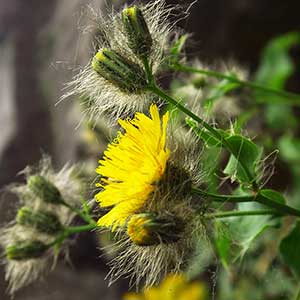Hieracium longiberbe
Hieracium sabaudum
long-bearded hawkweed, longbeard hawkweed
European hawkweed, European King devil, New England hawkweed, savoy hawkweed
proximally piloso-hirsute (hairs 2–8+ mm), sometimes glabrate, distally glabrous or piloso-hirsute (hairs 2–5+ mm).
proximally piloso-hirsute (hairs 2–3+ mm), distally glabrous or stellate-pubescent, sometimes piloso-hirsute as well (hairs 1–2 mm).
basal 0(–3+), cauline 6–12+;
blades spatulate to oblanceolate, 25–80(–100+) × 8–15(–25+) mm, lengths 3–5 times widths, bases ± cuneate, margins usually entire, rarely denticulate, apices obtuse to acute, abaxial faces piloso-hirsute (hairs 2–5+ mm), adaxial usually piloso-hirsute at margins (hairs 2–5+ mm), rarely glabrous.
basal 0, cauline 12–20+;
blades ± lanceolate, 30–80 × 10–25 mm, lengths 2–4+ times widths, bases cuneate, margins usually toothed, apices acute to acuminate, abaxial faces piloso-hirsute, adaxial glabrous or ± scabrellous (especially distal margins).
usually stellate-pubescent, sometimes piloso-hirsute and/or stipitate-glandular as well, rarely glabrous.
stellate-pubescent.
campanulate, 7–10 mm.
campanulate, 8–9 mm.
12–24+;
corollas yellow, 7–12 mm.
40–60+;
corollas yellow, ca. 10 mm.
12–15+, apices ± rounded, abaxial faces piloso-hirsute and stellate-pubescent.
21+, apices ± rounded, abaxial faces stellate-pubescent and stipitate-glandular.
bractlets 9–13+.
bractlets 21+.
(3–)6–12+ in corymbiform arrays.
25–30+ in corymbiform arrays.
columnar, ca. 3.5 mm;
pappi of 32–40+, white or stramineous bristles in ± 2 series, 5–6 mm.
columnar, 2.5–3 mm;
pappi of ca. 60+, stramineous bristles in ± 2 series, ca. 6 mm.
Hieracium longiberbe
Hieracium sabaudum
Hieracium longiberbe is known only from along the Columbia River.
(Discussion copyrighted by Flora of North America; reprinted with permission.)
- Local floras:
BC,
OR,
WA
- Local Web sites:
Flora NW,
Go Botany,
PNW Herbaria
WildflowerSearch
iNaturalist (observations)
USDA Plants Database
- LBJ Wildflower Center
- SEINet
- Plants of the World Online
- Encyclopedia of Life
- Wikipedia
- Google Image Search


